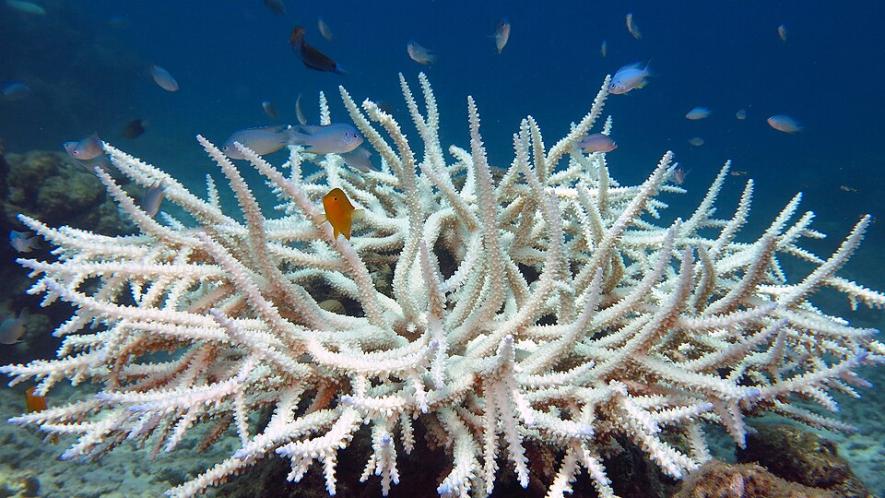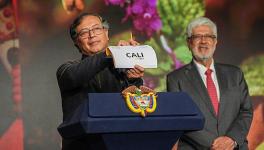‘Bluewashed’: How Beauty Industry Sells an Ocean-Friendly Illusion

The personal care industry has mastered the art of marketing eco-consciousness— evolving beyond familiar labels like “green,” “clean,” and “natural”—into a new wave of sea-inspired branding that claims to champion ocean conservation.
Terms such as “reef-safe” and “ocean-friendly” evoke images of crystalline waters and thriving coral reefs, yet behind the glossy marketing lies a regulatory murk. With no federal standards or clear definitions, consumers are left to navigate a tide of misleading labels.
As “ocean-safe” products flood the market—wrapped in teal hues and marine motifs—the illusion of ecological responsibility is gaining momentum, but it’s worth asking whether these gestures represent genuine sustainability or merely performative eco-branding.
Lorraine Dallmeier, CEO of Formula Botanica, warns that when sustainability becomes a marketing function, images can eclipse impact. “[M]arketing tells stories, it connects us with people, it builds communities, it grows businesses,” she says during the episode, “When Sustainability Reports to Marketing—Beauty’s Uncomfortable Truth,” on her Green Beauty Conversations podcast. “But when sustainability reports to marketing, we start prioritizing optics over action.”
The Critical Role of Coral Reefs in Supporting Biodiversity
Coral reefs are among the most biologically diverse ecosystems on Earth—hosting more than 25% of all marine species despite occupying less than 1% of the ocean floor, according to the Coral Reef Alliance.
The Environmental Protection Agency (EPA) categorises coral reefs as essential habitats, acting as nurseries and spawning grounds for countless fish species, crustaceans, mollusks, and marine food webs. According to the MIT Science Policy Review, coral reefs deliver substantial economic and cultural benefits—through fisheries, tourism, recreation, and even pharmaceutical discoveries—worth trillions of dollars globally.
The initial swell in ocean-centric marketing followed Hawaii’s 2018 ban on sunscreens containing oxybenzone and octinoxate—chemicals that filter ultraviolet (UV) radiation, which are harmful to ocean ecosystems.
The bill was informed by a 2015 study published in the Archives of Environmental Contamination and Toxicology, which examined how chemical sunscreens can damage coral larvae and cells, causing coral bleaching, making them vulnerable to infection, and preventing them from getting the nutrients needed for survival. The study found that “the chemicals cause bleaching, deformities, DNA damage, and ultimately death in coral when they’re washed off beachgoers or discharged into wastewater treatment plants and deposited into bodies of water,” states a CNN article.
The Hawaii legislation represented a watershed moment in environmental regulation, drawing global attention to the hidden ecological costs of UV chemical filters and inspiring other nations, such as the U.S. Virgin Islands, Palau, Aruba, and Thailand, to adopt similar restrictions to protect ocean life.
While the chemical impact of sunscreens on marine environments is well-documented, critics argue that the personal care product (PCP) industry doesn’t always honor the principles of the 2018 legislation passed by Hawaii.
How the Chemicals in Sunscreen Are Harming Ocean Life
According to a 2023 National Geographic article, “14,000 tons of sunscreen are thought to wash into the oceans each year,” and 82,000 chemicals from PCPs are found in the seas.
In a 2022 study, scientists from Stanford University revealed that animals process oxybenzone and UV radiation differently than humans; their metabolic systems alter the molecule in ways that make it reactive under sunlight, producing harmful reactive oxygen species that damage cells.
“The way sunscreens work is they chemically occlude the sun,” said oceanographer and educator David Hastings in an interview for this article. “And if you’re a coral trying to make a living by photosynthesizing, your symbiotic algae are sitting there, dying for the light.”
Even mineral sunscreens marketed as “reef-safe” can pose risks to ocean ecosystems under certain conditions. While they avoid chemical UV filters, many products contain zinc oxide or titanium dioxide, which are manufactured as nanoparticles. Due to their small size, these nanoparticles can bypass water treatment systems and bioaccumulate in marine organisms, according to a 2018 study published in Science of The Total Environment.
“Current research has only scratched the surface of understanding how these chemicals can affect marine life,” notes lead author of a 2025 report, Anneliese Hodge, PhD researcher at Plymouth Marine Laboratory and the University of Plymouth. “What’s particularly concerning is that these compounds are considered ‘pseudo-persistent pollutants’ due to their continuous introduction into marine environments as well as an overall lack of understanding of how they then interact with others in the sea.”
PCPs expose aquatic environments to various chemicals, including synthetic polymers, microplastics, siloxanes, and parabens.
Notably, microplastics—or microbeads—in facial scrubs and body washes have become one of the most visible examples of hidden plastic pollution; marine organisms—from plankton to fish—ingest the tiny plastic particles, which leads to oxidative stress, endocrine disruption, reduced growth, and altered behavior, according to a 2022 study published in Frontiers in Environmental Science.
Scientists warn that claims about “biodegradable” or “organic” microbeads made from plant starches, cellulose, or bioplastics such as polylactic acid can be misleading. Once released into the environment, these materials behave much like conventional plastics: They do not dissolve or readily break down in water and instead accumulate in rivers and oceans, according to the United Nations Environment Program.
The Business of ‘Bluewashing’
While sunscreens exposed the problem, chemical hazards extend across the spectrum of personal care products, and the industry’s growth only magnifies the stakes. Valued at $54.36 billion in 2024, the PCP market is projected to reach $90.40 billion by 2032, according to figures provided by Fortune Business Insights for 2025.
Although the overall personal care sector grew by a modest 2 percent in 2021, sales of “clean” beauty products jumped 8.1 percent, with items free of parabens, sulfates, and phthalates showing the most substantial gains at 13 percent, according to data from global marketing research firm NielsenIQ.
This shift in consumer behavior is reinforced by a 2020 McKinsey & Company survey, which found that between 60 percent and 70 percent of U.S. consumers are willing to pay more for products with sustainable packaging. Other research indicates that 68 percent will pay extra for items that specifically promote commitments to ocean conservation.
According to a CivicScience report, based on responses from April 2024, nearly 70 percent of beauty shoppers under the age of 35 are willing to spend more on sustainable personal care products, compared to 30-40 percent of older adults.
To reach this demographic, PCP brands are leveraging social media platforms—particularly Instagram, TikTok, and YouTube—where sustainability messaging, influencer collaborations, and user-generated content drive engagement. On Instagram, for instance, brands frequently pair ocean-inspired visuals with hashtags like #BlueBeauty, #SustainableSkincare, and #CleanBeauty, positioning their products within an aspirational lifestyle of environmental mindfulness.
Scrutinising Sustainability Claims
“Brands often begin by crafting a beautiful narrative, claims about packaging, ingredients, and impact, and they do that long before they’ve necessarily built the internal infrastructure to measure or manage any of it,” notes Formula Botanica’s Dallmeier, adding, “It’s then treated as a message, not a methodology.”
This can be particularly problematic in the complex realm of sustainable sourcing, which encompasses not only the origins of raw materials but also the environmental, social, and ethical impacts embedded throughout the supply chain—from harvesting and processing to labor practices and traceability.
“[Some brands] mislead consumers with words that are a simplification of concepts that aren’t simple,” says Adrien Dissous, senior vice president of Babo Botanicals. Dissous notes that the science is evolving, and while terms like “reef-safe” may come from good intentions, they can give the false impression that a product has no impact on ocean environments.
“We hear claims about sustainable palm oil, sustainable mica, and sustainable plastic,” says Dallmeier in her podcast series on sustainable beauty. “These are terms that don’t necessarily mean anything unless the systems behind them are robust, third-party verified, and transparently communicated,” she adds, emphasizing that deeper issues—such as whole life cycle, impact, carbon footprint, and marine ecosystem effect—rarely break through to consumers.
“Sustainable plastics are really a misnomer,” says Steven White, VP of Quality and Technical Services at iLabs, a PCP contract manufacturer, in an interview for this article. “You can start with something that is a plant-based material—such as corn starch or sugarcane—but it is often manipulated with enzymes and other catalysts to achieve a desired texture, color, or efficacy—converting it into a polymer.”
“A polymer is a plastic. So your material base may have been a plant, but you’re converting it into a plastic, which is persistent in the environment,” he explains.
White emphasizes the problematic disconnect between research and development (R&D) teams, contract manufacturers, and marketing departments: “We get a brief from the R&D side of the brand, but if they don’t have a brief from their marketing organization, the final product may not meet the claims the company is making,” he says.
“If sustainability is going to be meaningful, it has to be linked to R&D and operations,” says Dallmeier. “It has to be cross-functional, not preformative; otherwise, it’s just another campaign that gets treated as a content pillar, and then it lives in the slide deck, not in procurement systems or packaging briefs, and ultimately, it becomes just another way to convince people to buy more but feel better about it.”
‘Virtue Signaling’ and ‘Charity-Washing’
PCP brands increasingly tout partnerships that promote sustainable sourcing, marine restoration, corporate giving, and conservation events. While some of these initiatives may contribute to conservation efforts, critics caution that many amount to “virtue signaling” or “charity-washing,” where sustainability is treated as a seasonal campaign—timed for National Ocean Month or Earth Day or tied to a new product launch—rather than being fully integrated into a company’s operations.
“[Corporations]… may contribute some small (but very visible) amount of money toward the solution for a problem that they themselves have contributed to in the hunt for outsize profits,” writer Paul Constant observed in a 2019 Business Insider article about corporate philanthropic campaigns, adding, “The glow of philanthropic giving obscures the exponential wealth that the corporation draws from the situation they’re ostensibly trying to solve. It is, literally, throwing good money after bad.”
Leaders of the PCP industry have invested heavily in ocean conservation initiatives. For example, beauty brand L’Oréal partners with the Great Barrier Reef Foundation through the L’Oréal Fund for Nature Regeneration. Estée Lauder has established the La Mer Blue Heart Ocean Fund, and Shiseido stewards the Shiseido Blue Project in association with World Surf League (WSL) and WSL’s environmental initiative PURE.
Lack of Regulation in Marine-Safe Labeling in the US
In the United States, there are no federal standards or certifications to ensure that “ocean-safe” claims are accurate or meaningful. At the federal level, the Environmental Protection Agency (EPA) and the Food and Drug Administration (FDA) provide some oversight. The FDA regulates the efficacy and safety of sunscreens for humans, while the EPA evaluates the environmental impacts of certain chemicals under broader statutes; it doesn’t enforce ocean-centric marketing language.
In recent years, the US Federal Trade Commission (FTC) has signaled an increased scrutiny of environmental claims in the personal care sector through updates to its Green Guides, clarifying terms such as “biodegradable” and “non-toxic.” However, some academic law journals argue that the guides remain vague and non-binding, resulting in limited enforcement and accountability.
At the state level, there are regulatory actions that are more prescriptive. In 2020, California enacted the Toxic-Free Cosmetics Act, which bans 24 ingredients, including formaldehyde, parabens, and mercury. In 2024, New York adopted regulations to reduce the presence of 1,4-dioxane—a byproduct of ethoxylated surfactants used in shampoos, body washes, and cosmetics.
Nonetheless, allegations of misleading claims have made their way to the courtroom. Edgewell Personal Care, the parent company of Banana Boat and Hawaiian Tropic, faced legal action in Australia in 2025 for falsely labeling these products as “reef-friendly” when, in fact, they contained chemicals harmful to marine life. Target faced a class action suit for deceptively marketing its private label up&up sunscreens as safe for coral reefs in 2024, and the Santa Clara District Attorney’s Office secured settlements with Sun Bum and Supergoop in 2024 for misleading labeling as reef-safe.” In October 2020, Tropical Seas, Inc. agreed to a settlement after the Sonoma County DA’s office (alongside 21 other California district attorneys) found that the company’s “reef-safe” sunscreens could not substantiate that claim.
Ensuring Standards That Guarantee Sustainability
Private certifiers have become the de facto regulators of the PCP industry—issuing seals and logos that signal ethical sourcing, cruelty-free practices, and environmental responsibility. However, they also represent a commercial ecosystem of their own—brands must pay for audits, renewals, and logo-licensing fees that can range from a few hundred to several thousand dollars, depending on the company’s size and sales volume, according to the organization Truth and Advertising.
These certifications provide valuable shorthand for consumers seeking assurance in a crowded marketplace, but the payment structure underscores a built-in tension: Brands fund the very entities that verify them.
Among the most globally recognized standards ensuring that products meet strict requirements for ingredient sourcing, manufacturing processes, and environmental impact are COSMOS Organic and Ecocert. The Environmental Working Group’s EWG Verified mark similarly signals that a product is free from EWG’s chemicals of concern and meets stringent health and transparency standards. The Green Seal GS-50 standard certifies personal care products that are low in volatile organic compounds (VOCs), biodegradable, and free from carcinogens, mutagens, and reproductive toxins, protecting both human and environmental health.
“While conscious consumer behavior plays a vital role, corporate commitments and innovation investments will shape the future,” says Marc Desmarais, a product development activist at Origin by Ocean.
Dallmeier adds, “It’s no longer enough for sustainability to sound good. It has to be good, even when nobody’s looking.”
Kate Petty is an educator, writer, yoga teacher, and activist. The views are personal.
This article was produced by Earth • Food • Life, a project of the Independent Media Institute.
Courtesy: Independent Media Institute
Get the latest reports & analysis with people's perspective on Protests, movements & deep analytical videos, discussions of the current affairs in your Telegram app. Subscribe to NewsClick's Telegram channel & get Real-Time updates on stories, as they get published on our website.
























